Learning how to read music can completely transform your tracks and enhance your music theory skills (and production skills as well).
It can help you understand the structure behind your favorite songs, break down complex arrangements, and make learning new pieces super simple.
When you learn how to read music, you’ll be able to knock out enchanting melodies, break down rhythms, and understand key signatures on the spot.
It will really help you when you’re writing your own music and producing your own beats, which is why we’re covering:
- Basics of sheet music notation/musical symbols ✓
- Recognizing lines and spaces ✓
- Identifying a bass clef, treble clef, etc. ✓
- Understanding time signatures ✓
- Counting note values and rhythms ✓
- Everything about a quarter note, eighth note, etc. ✓
- Reading key signatures and scales ✓
- Spotting intervals and chords ✓
- Using dynamics & articulation when you read sheet music ✓
- Decoding expression markings ✓
- How to sight read music ✓
- Everything you need to learn how to read music ✓
This way, you’ll know all the basics of reading sheet music so you can confidently follow along with any score and pick up new pieces like a boss.
Your music-reading skills and your music theory knowledge will level up fast.
Just remember, it’s all about practice and having fun with the process 一 don’t get too frustrated along the way as it can be a little tricky at first.
Table of Contents
- How to Read Music: Breaking it Down
- The Basics of Sheet Music Notation: Breaking it Down
- Understanding Rhythm & Time Signatures
- Reading Key Signatures and Scales
- Intervals and Chords in Sheet Music
- Dynamics, Articulations, and Expression Marks
- Advanced Reading Techniques and Sight-Reading
- Final Thoughts About How to Read Music
How to Read Music: Breaking it Down
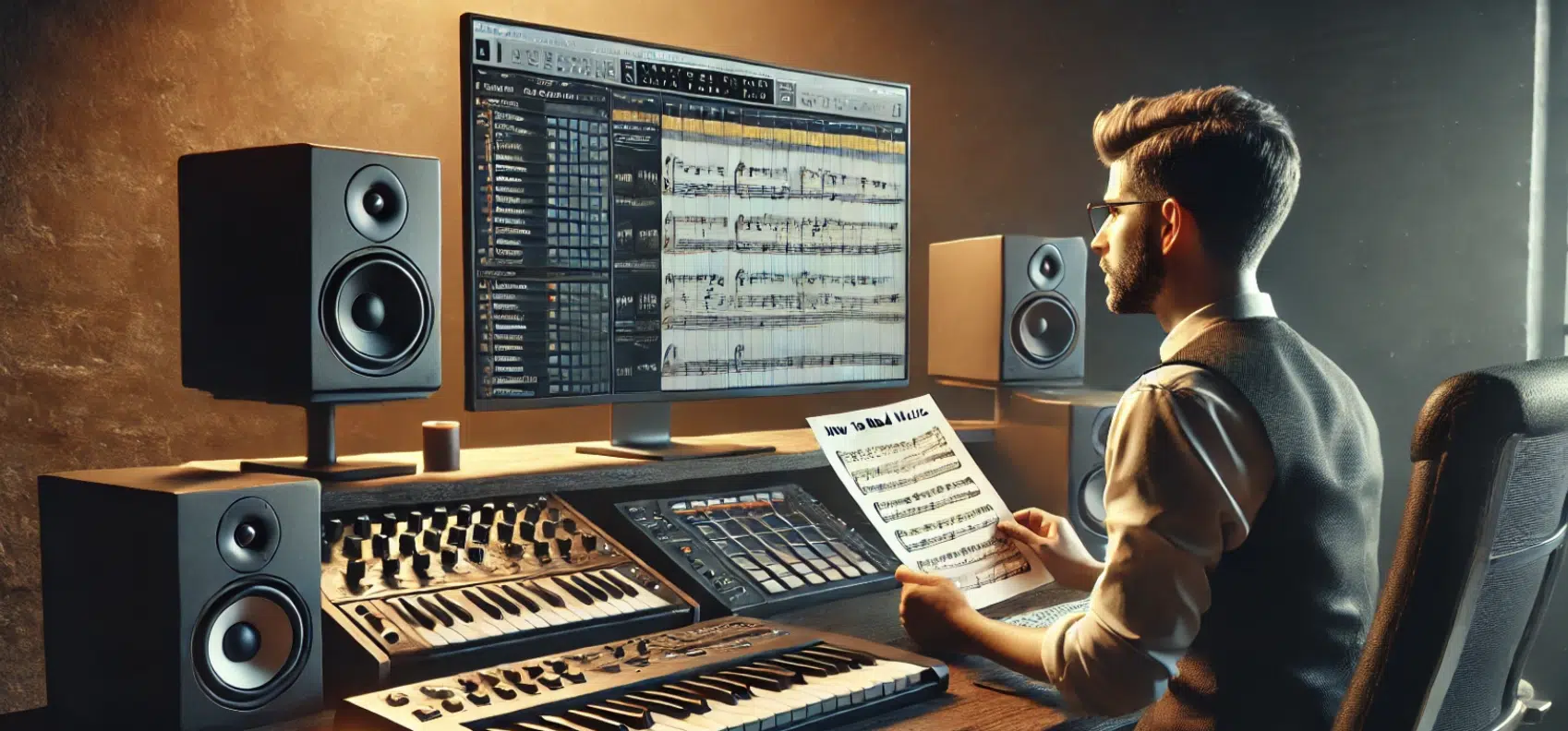
Reading music can seem like a complex puzzle, but once you know the basics, it becomes an invaluable tool for any music producer or artist.
Knowing how to read music opens up a whole new layer of musical insight, letting you:
- Dive deeper into arrangements
- Learn all about rhythm, beats, symbols, etc.
- Analyze sheet music
- Recreate parts precisely
Not only does it enhance your music-reading skills, but it also lets you really get creative with your music theory techniques when producing.
So, if you want to learn how to read music, you’ve definitely come to the right place.
The Basics of Sheet Music Notation: Breaking it Down
Before diving right in and attempting to read sheet music you have to nail the basics down first (basic symbols that make up musical notation). From the structure of the staff to understanding different musical notes and their placements, let’s break down all the most important sheet music essentials.
-
The Music Staff: Lines and Spaces
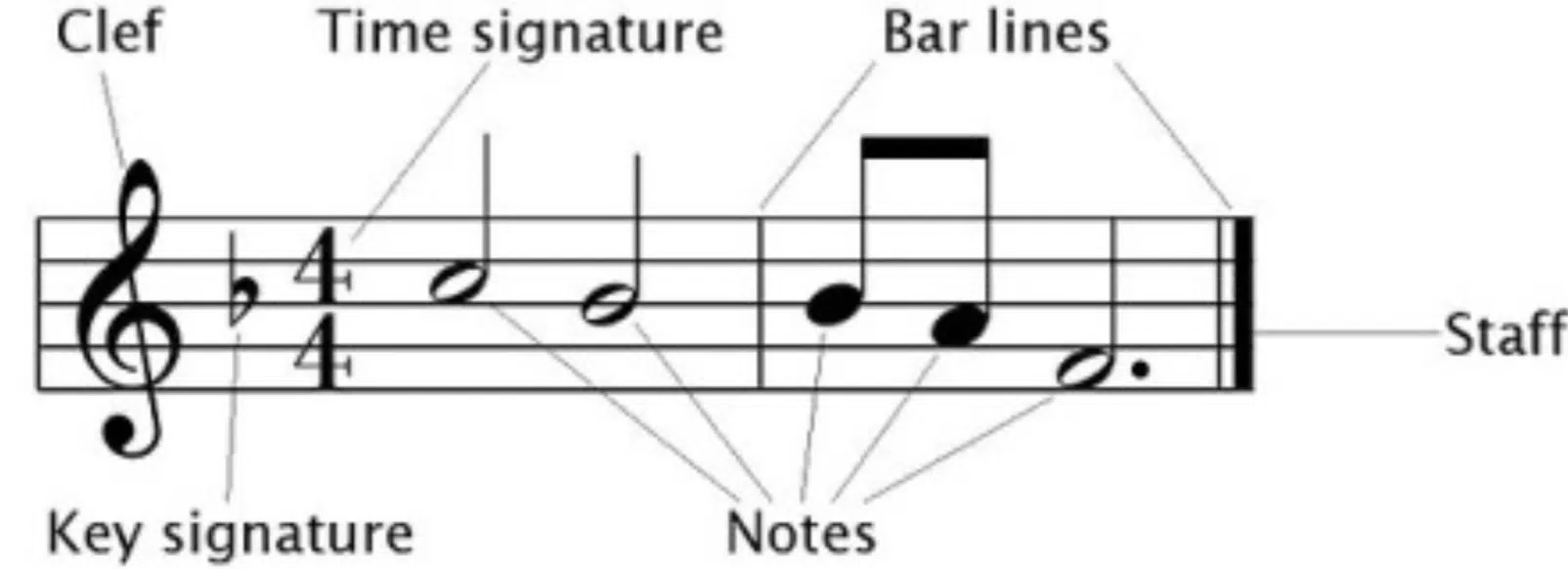
In musical notation, the staff is what you’ll use to notate musical pitches, so needless to say, it’s insanely important when learning how to read music.
The music staff consists of five horizontal lines and four spaces, each representing a different pitch.
Every line and space corresponds to a different note as well, which changes based on whether we’re working in the treble clef or bass clef.
In the treble clef (the higher-pitched one), the lines are E-G-B-D-F (we remember it with “Every Good Boy Does Fine”), and the spaces are F-A-C-E.
For bass clef (which covers lower pitches), the lines are G-B-D-F-A (often remembered as “Good Boys Do Fine Always”), and the spaces are A-C-E-G or “All Cows Eat Grass.”
These lines and spaces are like the cheat codes to all the music notes you’ll come across when reading sheet music.
To add even more notes, composers use what’s called ‘ledger lines,’ which are extra lines above or below the staff for pitches beyond the regular range.
Let’s take middle C for example… It sits just below the treble staff or just above the bass staff on its own ledger line.
This note, Middle C, acts as a common ground between both clefs, which makes it a key point in understanding both your piano/keyboard and sheet music structure.
Without understanding this five-line framework, it’d be nearly impossible to start reading sheet music like a professional, so don’t overlook it.
Pro Tip: When learning how to read music, remember to focus on the five lines of the staff by associating each with a memorable phrase like “Every Good Boy Does Fine” for line notes in the treble clef.
Pay attention to note heads as well because their position on the lines or spaces directly tells you the pitch.
Start practicing note identification daily by quickly recognizing these positions, which will train your eyes to spot line notes at a glance.
With constant practice and dedication, you’ll build the speed and accuracy needed to understand how to read music like a boss.
-
Bass and Treble Clefs
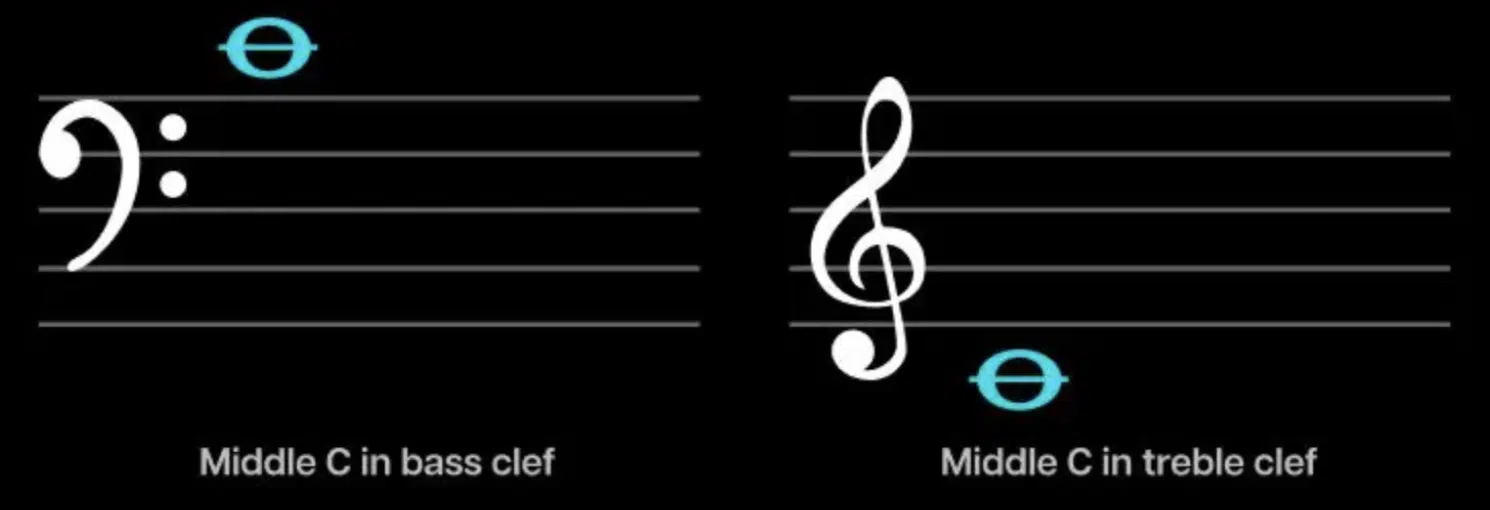
In sheet music, the treble and bass clefs act as the foundation for identifying where each note sits on the staff.
The treble clef (aka the G clef) primarily handles higher pitches as we just talked about.
When reading treble clef notes, you’ll start by identifying that the note on the bottom line is E and you’ll go up from there.
Each line goes up alphabetically (E-G-B-D-F), with the phrase “Every Good Boy Does Fine” as a handy memory aid.
Let’s say you spot a note head on the second line and it’s a G note… If you see a note head in the space above that line, it’s an A (the next letter in the musical alphabet).
Just remember the spaces in the treble clef spell out F-A-C-E from bottom to top.
The bass clef (or F clef) focuses on the lower range. It’s called the F clef because it centers around the F line on the staff 一 making F the most significant note in this clef.
For example, let’s say you’re working on a bassline and come across a note head in the third space up on the bass clef, that would be E.
This is a very common bass note that sits perfectly in the low-frequency range.
Another example: if a note head is on the second line from the top, it’s an F, which you can play to add depth to your low-end.
Just keep in mind that when you look at sheet music notes in the bass clef, each note represents a lower frequency, not a higher one.
As producers, we deal with these ranges all the time when we’re working with EQs, so it pays to know the exact note placements here.
Together, these bass and treble clefs offer the full spectrum of pitches you’ll find in sheet music so you can read sheet music all day.
-
Notes and Rests: Symbols and Durations
Notes and rests are the building blocks of rhythm and melody in sheet music and if you want to read sheet music, you have to know them like the back of your hand.
*NOTES
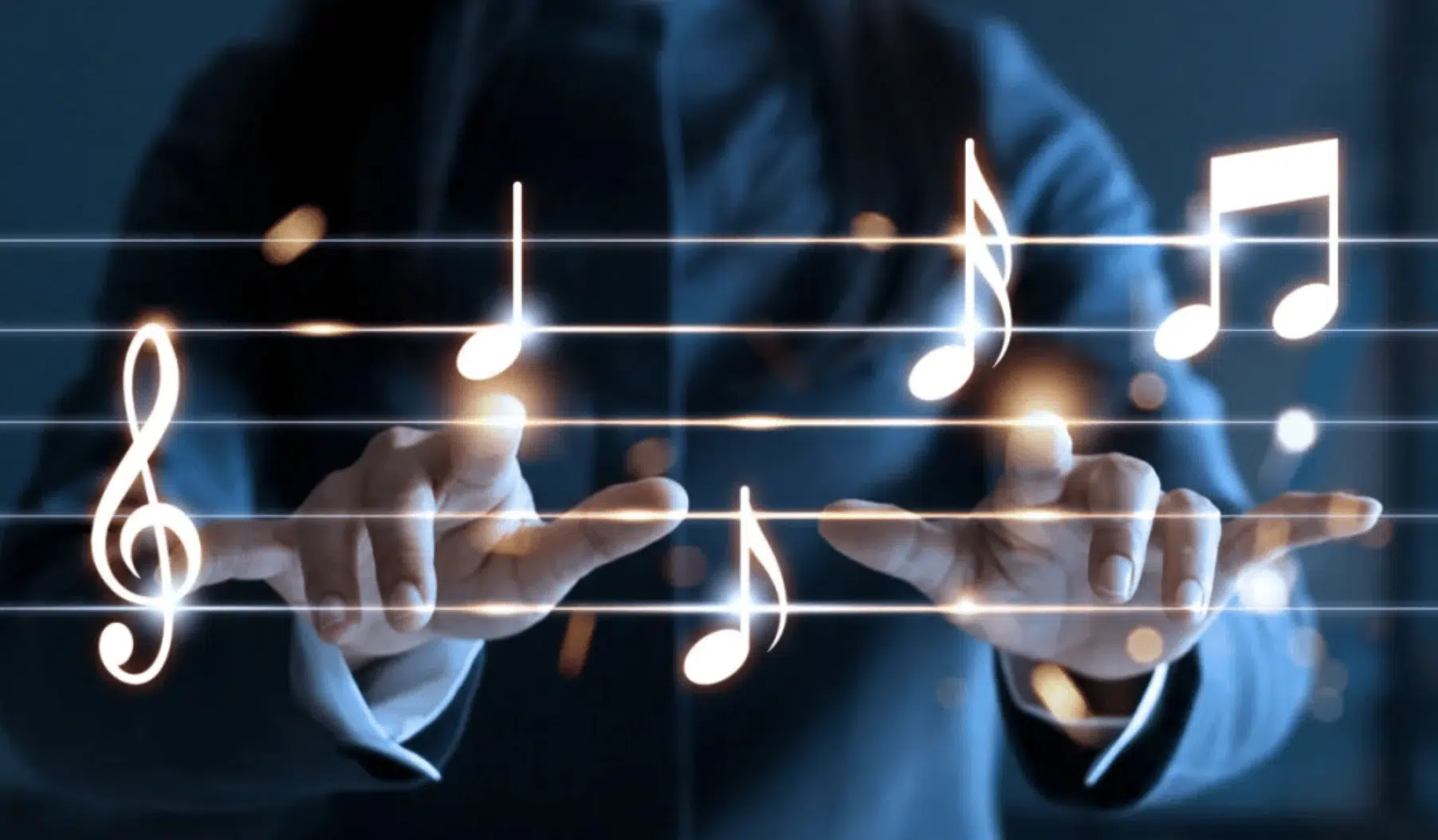
Each note in musical notation has a specific duration, which indicates how long that specific note should be held down for.
A whole note has an empty note head without a stem, lasting four beats in 4/4 time. Holding down a note on the piano and counting “1-2-3-4” steadily is the feel of a whole note. When reading sheet music, this note fills an entire measure in 4/4 time.
A half note is represented by an empty note head with a stem, lasting two beats. If you see a half note in a measure, you’ll count “1-2” for each note. For example, if you see two half notes in a single measure, they’ll add up to a full four beats.
A quarter note has a filled-in note head with a stem and lasts for one beat. If you see four quarter notes in a measure of 4/4 time, each note is held for a single beat 一 creating a steady rhythm. This is the standard beat in most sheet music.
Moving to smaller durations, an eighth note (a filled-in note head with a stem and a single flag) represents half a beat. When you see eighth notes grouped in twos, they’re connected by a single beam and counted as “1 and 2 and…” within each beat.
Side note, eighth notes are great for creating faster rhythmic tracks, and you’ll often see them in more upbeat sections of music.
*RESTS
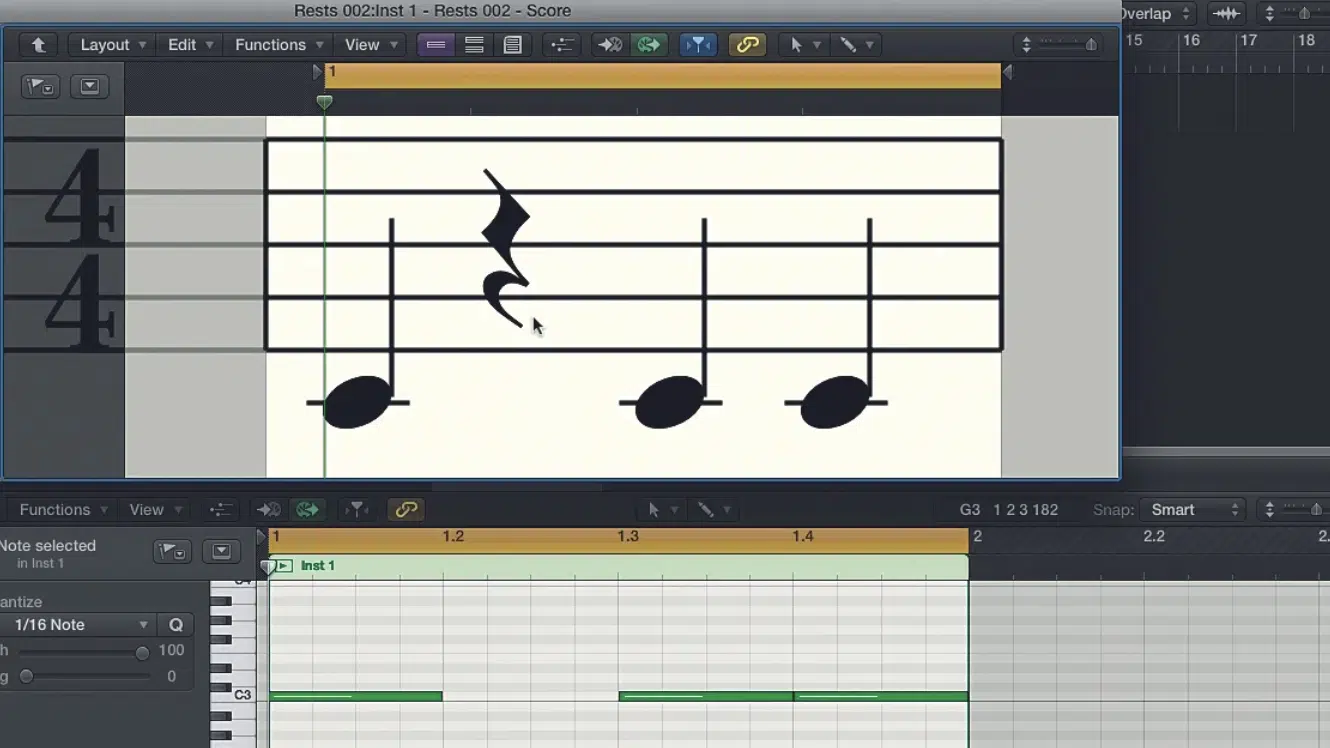
Rests represent silence, which is really all you need to know about them.
A whole rest (a small rectangle hanging down from the fourth line of the staff) indicates four beats of silence. Basically, going through an entire measure in 4/4 time without playing any sound.
A half rest (a small rectangle sitting on top of the third line) indicates two beats of silence. So if you see a half rest in a measure, you’ll pause for the first two beats, then play notes in the remaining beats.
A quarter rest (a squiggly symbol) signals one beat of silence. For example, if a measure has two quarter notes followed by a quarter rest and then another quarter note, you’ll play the first two beats, rest on the third, and play again on the fourth.
An eighth rest (a small curved symbol resembling a number 7) signals half a beat of silence. In faster music, eighth rests are common, often appearing in syncopated rhythms where you’re playing off the beat.
Whether you’re reading notes on the lines or space notes, knowing how each note’s duration and rest affect the overall rhythm is key for interpreting sheet music correctly.
-
Pitch and Octave Notation
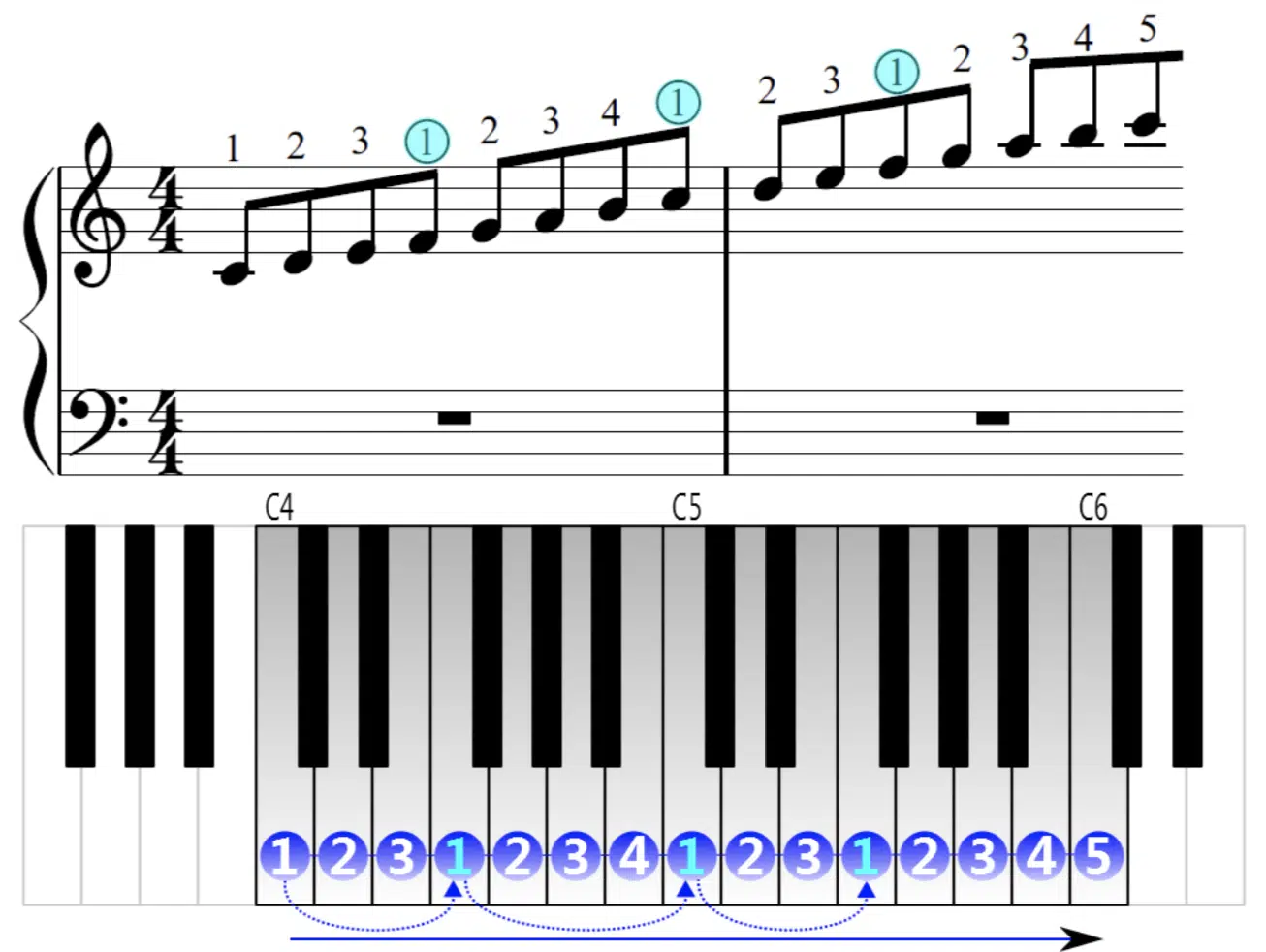
C Major Octaves
Pitch defines how high or low a note sounds, and octave notation helps us categorize these pitches when reading sheet music.
Starting from Middle C on the piano keyboard (C4), you can move up or down by octaves, each representing a set range of notes.
Each octave moves up by one note letter, from C to B, and repeats in a higher or lower register as we touched upon.
For example, if we start on Middle C, the next C up would be in the following octave, which is labeled as C5 if Middle C is considered C4.
On the other hand, moving down one octave from Middle C brings you to C3 (a lower range used frequently for basslines).
When you’re working in your DAW, you’ll see these octave labels on the piano roll so you really won’t have to worry about it, but knowing is always good for music theory.
It helps make sure that you’re working within the right pitch range, whether you’re laying down a melody or even creating sheet music for other musicians.
For instance if you’re creating a bassline and want a deep, resonant sound 一 working within the C2 to C3 range ensures you’re in the correct low octave.
Or, if you’re aiming for a brighter, higher-pitched melody, you’d work in the C5 to C6 range which is perfect.
Understanding octave notation not only improves your ability to read music but also allows you to relay precise pitch information to other musicians/producers.
NOTE: When you’re learning how to read music, especially sheet music, these octave shifts may be indicated with symbols like 8va (one octave up) or 8vb (one octave down), which means you can play the same notes but in different pitch ranges.
Understanding Rhythm & Time Signatures
Rhythm is all about helping us understand how notes are arranged in time. Mastering time signatures and rhythmic notation will really help you read sheet music like an absolute boss (and enhance your production skills in the process).
-
Beats, Measures, and Bar Lines

The beat is the basic pulse of any song… The steady underlying rhythm that you instinctively tap your foot to.
In sheet music, beats are organized into groups called measures, which are separated by bar lines.
Each measure contains a specific number of beats, determined by the time signature, which we’ll break down in the following section.
For example, in a 4/4 time signature, each measure has four beats, with each beat often represented by a quarter note.
These bar lines visually split up the sheet music into smaller sections 一 making it easier to read music in little chunks.
PRO TIP: Practice counting along with the beats as you read, so you develop a sense for the rhythm of the music.
Also, remember that in genres like pop music, measures and beats tend to have a repetitive structure, which makes it easier to predict the rhythm.
Understanding how beats and measures work is essential for breaking down more complex time signatures and rhythmic patterns when reading sheet music.
-
Time Signatures: Common and Complex
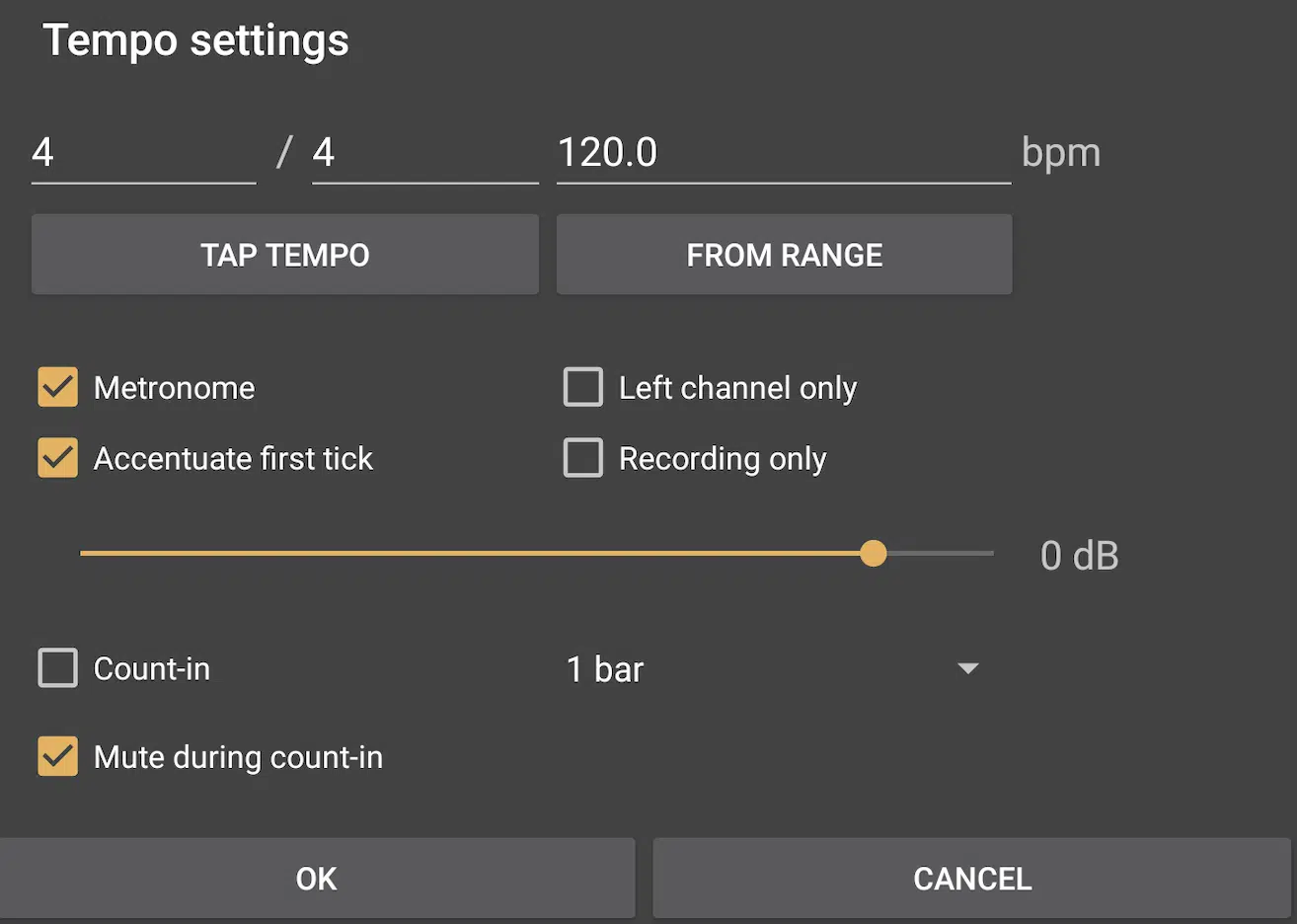
Time signatures are found at the very beginning of each piece of sheet music, and they can help you learn how to read music by telling you the:
- Number of beats in each measure
- Type of note that counts as one beat
The top number in a time signature indicates how many beats are in a measure, while the bottom number tells us the note value for each beat.
For example, in a 4/4 time signature (often called “common time”), there are four quarter notes in each measure, so each quarter note equals one beat.
This means you’ll count “1-2-3-4” in each measure, with each quarter note lasting for one beat.
Another common time signature is 3/4, which means there are three beats per measure 一 typically giving a more ‘flowy,’ rhythmic feel that you’ll hear in pop or melodic trap.
In 3/4 time, you’d count each measure as “1-2-3,” again, with each beat represented by a quarter note.
Then there are more complex time signatures, like 5/4 or 7/8…
5/4 time, for example, has five beats per measure, which is often broken down into a 3-2 or 2-3 pattern (e.g., “1-2-3, 1-2” or “1-2, 1-2-3”).
While not as common, you can find 5/4 used in certain electronic or trap tracks that want to create a more unpredictable or syncopated rhythm.
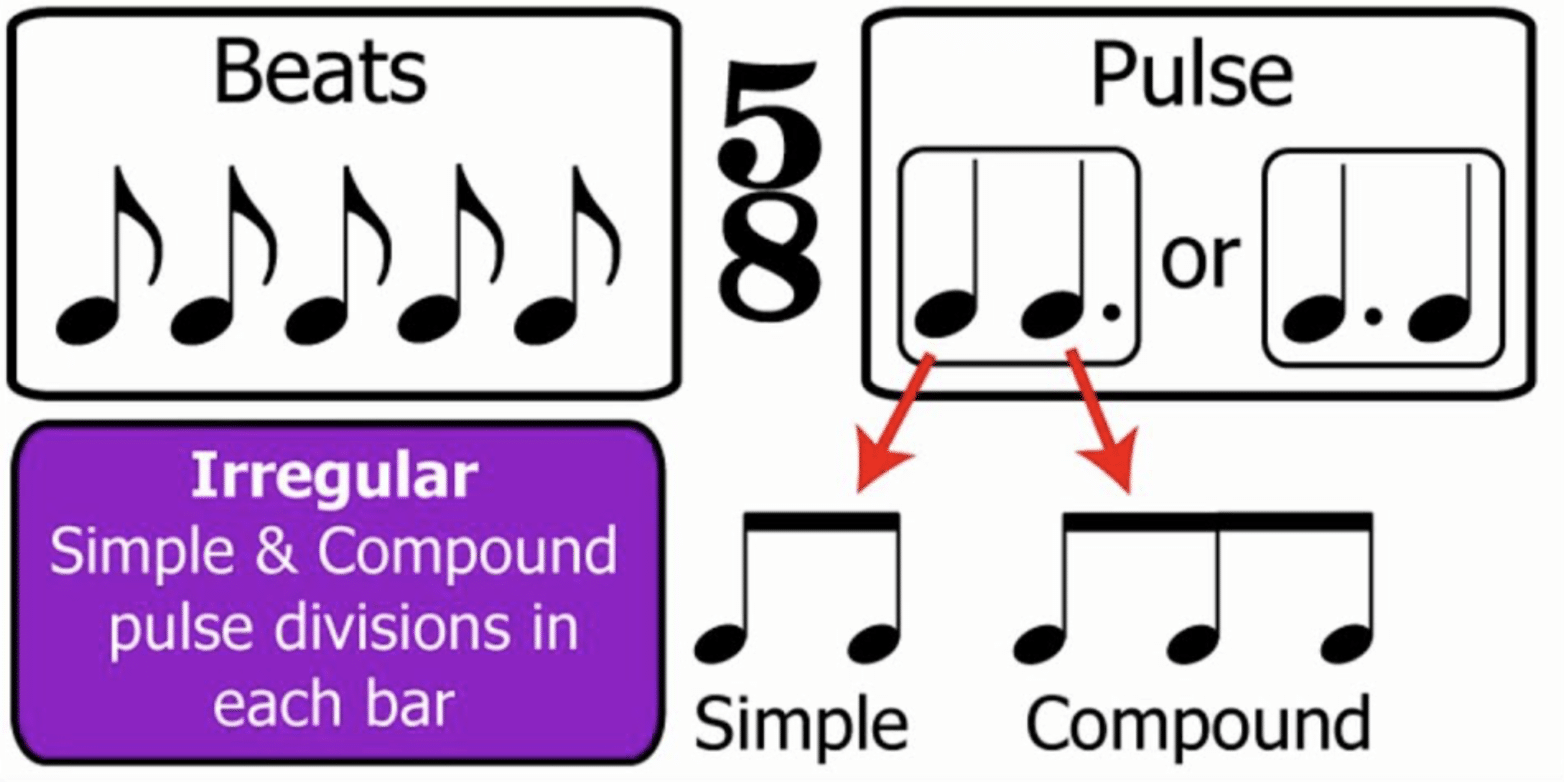
7/8 time is seven beats per measure, which can be broken down in patterns like 2-2-3 or 3-2-2 for easier counting.
You might use 7/8 used in a build-up section in EDM, where the off-kilter beat can create tension leading up to the drop that people go crazy for.
This will give your track a unique groove, which can be super cool when mixed with more straightforward sections like 4/4 to keep the energy dynamic.
If you’re practicing sight reading in these time signatures, try clapping or tapping out each beat to get comfortable with the rhythm.
Just remember that signatures are key for anyone wanting to read music like a pro, as they set the overall rhythmic framework for the piece.
-
Note Values and Counting Rhythms
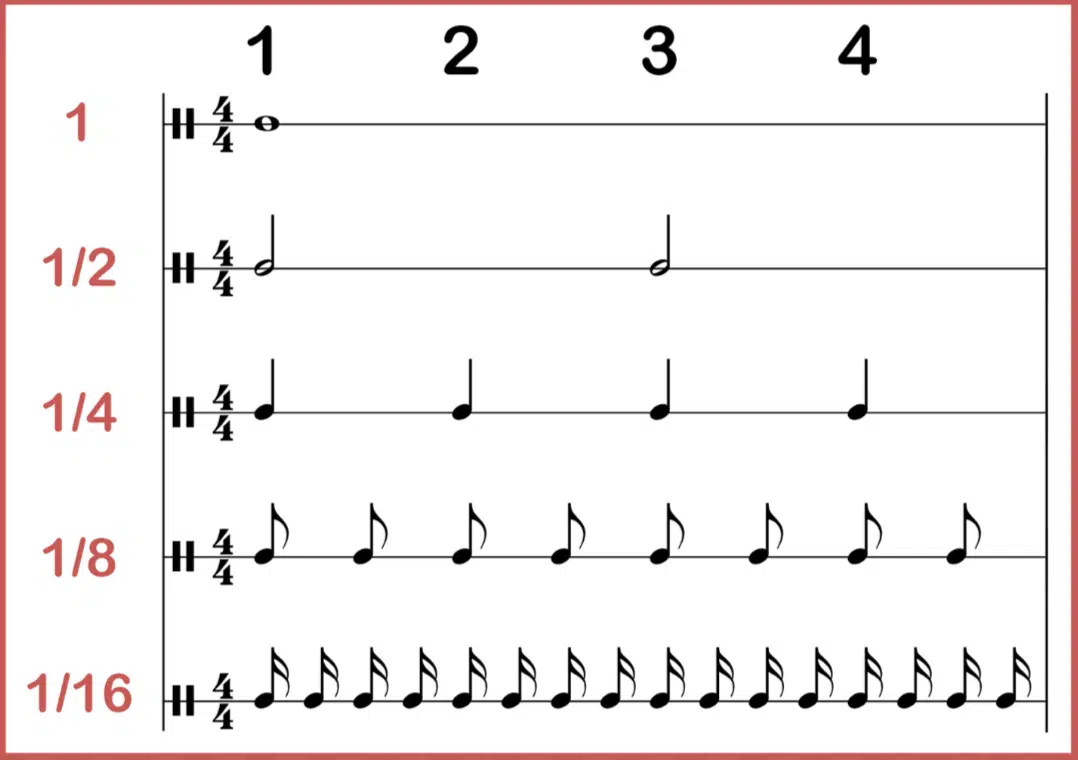
Note values are music symbols that tell us the duration of each note in a measure, and they’re foundational in learning how to read music.
The whole note represents the longest duration, often held for four beats in 4/4 time, while a half note is held for two beats.
Let’s break it down easily:
- The quarter note lasts for one beat
- The eighth note represents half a beat
- The sixteenth note covers just a quarter of a beat
Each of these note values has a specific shape in music notation, like a filled-in or open note head with or without a stem 一 making them easy to identify.
When counting rhythms, start by practicing with whole notes, half notes, and quarter notes to get a feel for the fundamental pulses in a song.
For example, if you’re reading a melody in 4/4 time with alternating quarter notes and half notes, count “1-2-3-4” and hold the half notes across two beats while playing each quarter note on its beat.
When you’re attempting to learn how to read sheet music/read music notes, try practicing note values with a metronome to maintain steady timing as you count.
Developing a strong grasp of note values and rhythm will make reading sheet music a lot more manageable, which is why I felt obligated to break it down once again.
Reading Key Signatures and Scales
Moving along, we have key signatures. When learning how to read music, you’ll need to know that key signatures determine which notes are sharp or flat throughout a piece. Mastering scales and the Circle of Fifths will help you understand the tonal framework of most songs, whether in sheet music or in your own tracks.
-
Understanding Key Signatures
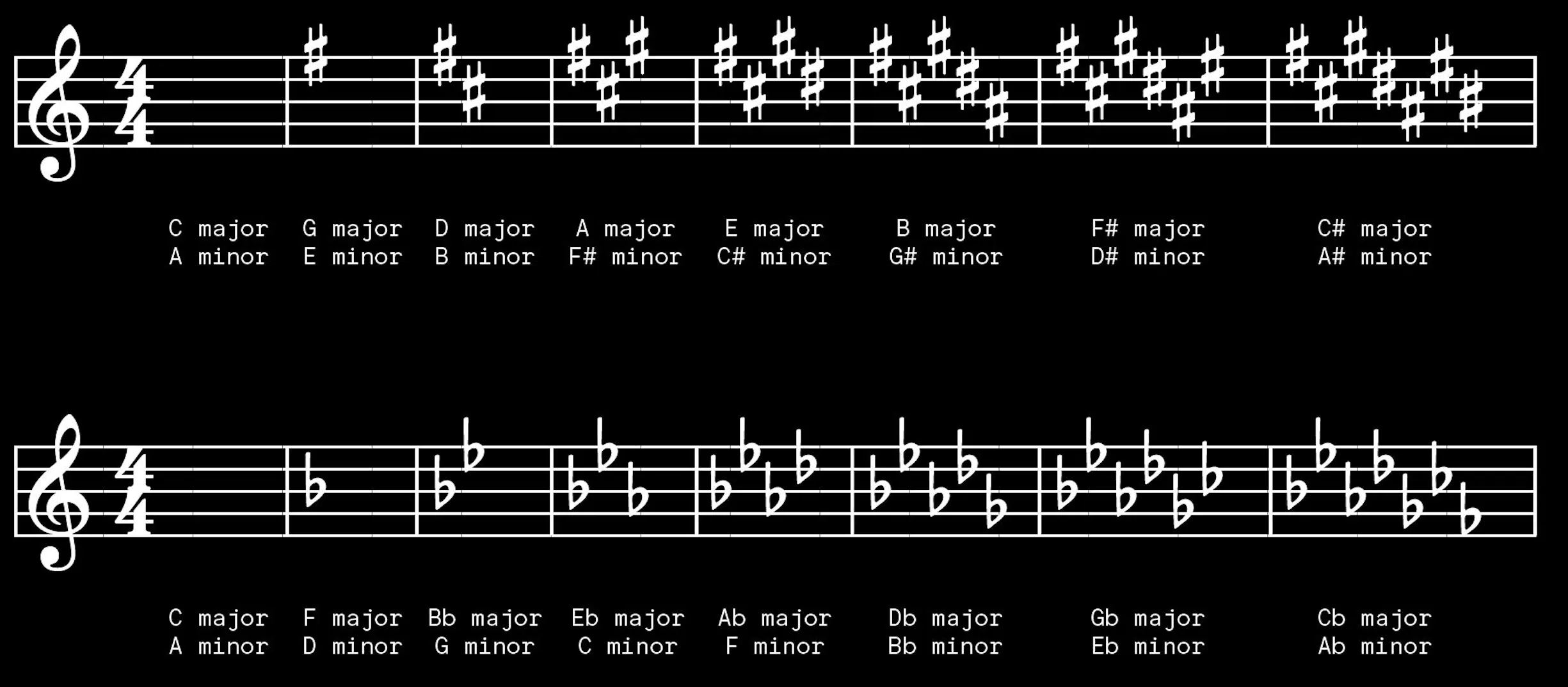
A key signature is a set of sharp (♯) or flat (♭) symbols located at the very beginning of each staff, right after the clef.
The key signature indicates which notes are consistently sharp or flat throughout the piece 一 setting the foundation for the song’s tonal center.
For example, if you see two sharps in the key signature (F♯ and C♯), you’re in the key of D major.
This means that every F and C note should be played as F♯ and C♯, unless otherwise marked of course.
To make this easier to memorize, try learning about the Circle of Fifths (below), which organizes key signatures in a visual circle based on their number of sharps or flats.
PRO TIP: Remember that key signatures with sharps follow the pattern: G, D, A, E, B, F♯, C♯, adding a sharp with each new key.
Those with flats follow the order: F, B♭, E♭, A♭, D♭, G♭, C♭.
Knowing this order will make identifying and reading sheet music much smoother, especially if you encounter a new key signature for the first time.
-
Major and Minor Scales on Sheet Music
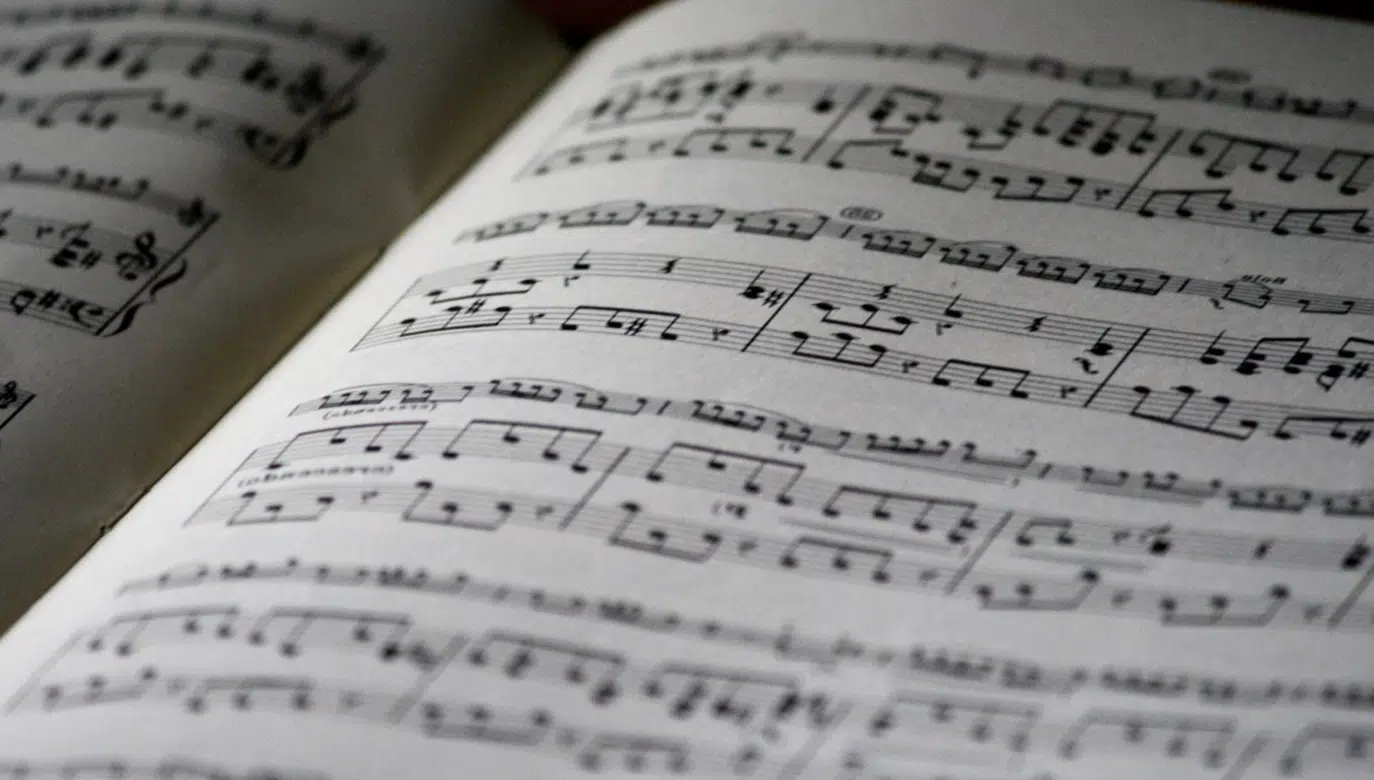
Every key signature corresponds to a major or minor scale, which is a specific sequence of notes following a particular pattern of whole steps and half steps.
Remember, a half-step = one semitone and a whole step = a whole tone.
In sheet music, the C major scale, which has no sharps or flats in its key signature as we just discussed, consists of the notes C-D-E-F-G-A-B-C.
With C being the starting note and the ending note, of course.
This scale is an easy one to start with since it doesn’t involve any accidentals 一 making it straightforward to recognize and play.
If you’re creating a beat in C major in your DAW, the entire scale will stick to the white key, giving it a straightforward, bright sound.
For a minor scale, we start with A minor, which also has no sharps or flats (A-B-C-D-E-F-G-A), and is known as the relative minor of C major.
It has a much darker, more gloomy sound than the major scale of course.
For instance, if you’re looking at a sheet music piece in G major, remember that it includes one sharp (F♯), so every F will be played as F♯.
Meanwhile, the G minor scale has two flats (B♭ and E♭) in its key signature.
Knowing major scales and their relative minors can give you an immediate sense of the song’s mood, whether bright and uplifting or darker and more introspective.
This is key if you want to really understand the tonal shifts in sheet music or incorporate them into your own tracks.
Whether you’re laying down melodies, building harmonies, or play around with key changes, recognizing these key signatures helps you create music with the exact vibe you’re aiming for.
-
Pro Tip: Circle of Fifths (Visualizing Key Signatures)
The Circle of Fifths is an incredibly helpful tool for understanding key signatures and relationships between different keys.
Starting at C (no sharps or flats) in the circle:
- Each clockwise step adds a sharp.
- Each counterclockwise step adds a flat.
For instance, one step clockwise from C is G major, which has one sharp (F♯).
This continues around the circle, so by the time you reach the other side, you’re in C♯ major, with seven sharps… It’s pretty simple once you get the hang of it.
When you’re reading sheet music, using the Circle of Fifths helps you recognize key signatures more quickly.
This is especially beneficial if you’re sight-reading or switching between multiple keys.
For producers like us, understanding this circle is also useful when experimenting with modulations or transitions between keys in a song.
As you move clockwise in fifths, you can think of it as moving into brighter or sharper-sounding keys, while moving counterclockwise gives a darker or flatter sound.
Knowing how to visualize key signatures with the Circle of Fifths can help you learn how to read music properly and deepen your music theory knowledge.
Intervals and Chords in Sheet Music
Recognizing intervals and chords is another key technique for understanding the harmonic structure in sheet music. Knowing how to read and build chords will make it easier to read music and add depth to your compositions/productions.
-
Recognizing Intervals: Seconds, Thirds, Fourths, Etc.
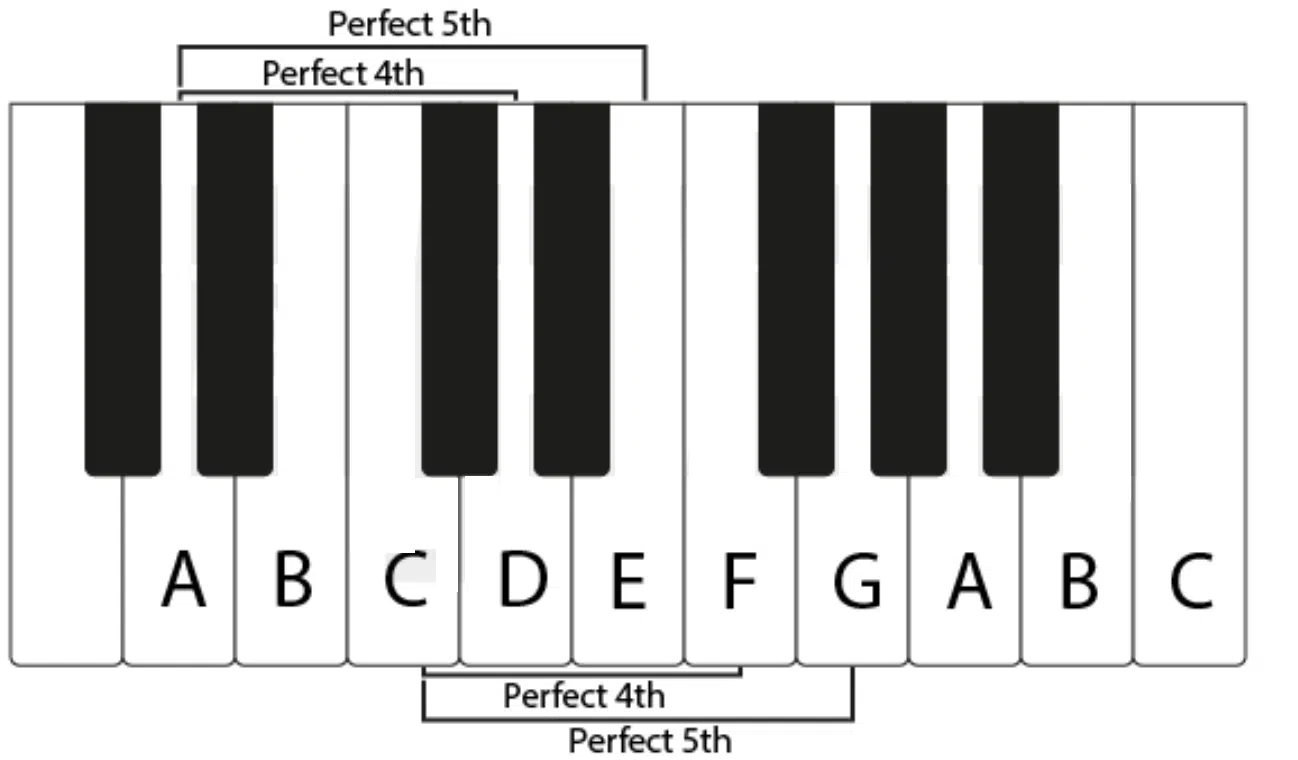
An interval is simply the distance between two notes in sheet music, and understanding intervals helps you lock down harmonic and melodic relationships.
For example, a second (like C to D) is the smallest interval in the diatonic scale, spanning only one step.
While a third (like C to E) skips one note and gives a more harmonious feel.
Fourths and fifths are intervals you’ll instantly recognize in chord progressions and melodies across popular genres because of their balanced sound…
For instance, a fourth from C to F feels strong and solid.
When you see an interval of a sixth or a seventh, you’re looking at larger distances that can add emotional depth and tension (seen in more complex music phrases).
As you read music, look for these intervals to quickly recognize melodic patterns.
If you notice a third repeating across multiple measures, you’re likely seeing a melody line that will flow smoothly from note to note.
PRO TIP: As you work through sheet music, try identifying intervals by their shapes on the staff; seconds are close, with notes almost touching, while thirds skip a line or space.
With practice, reading sheet music with intervals will become second nature 一 letting you read faster and play more accurately.
-
Basic Chords and Chord Symbols in Notation
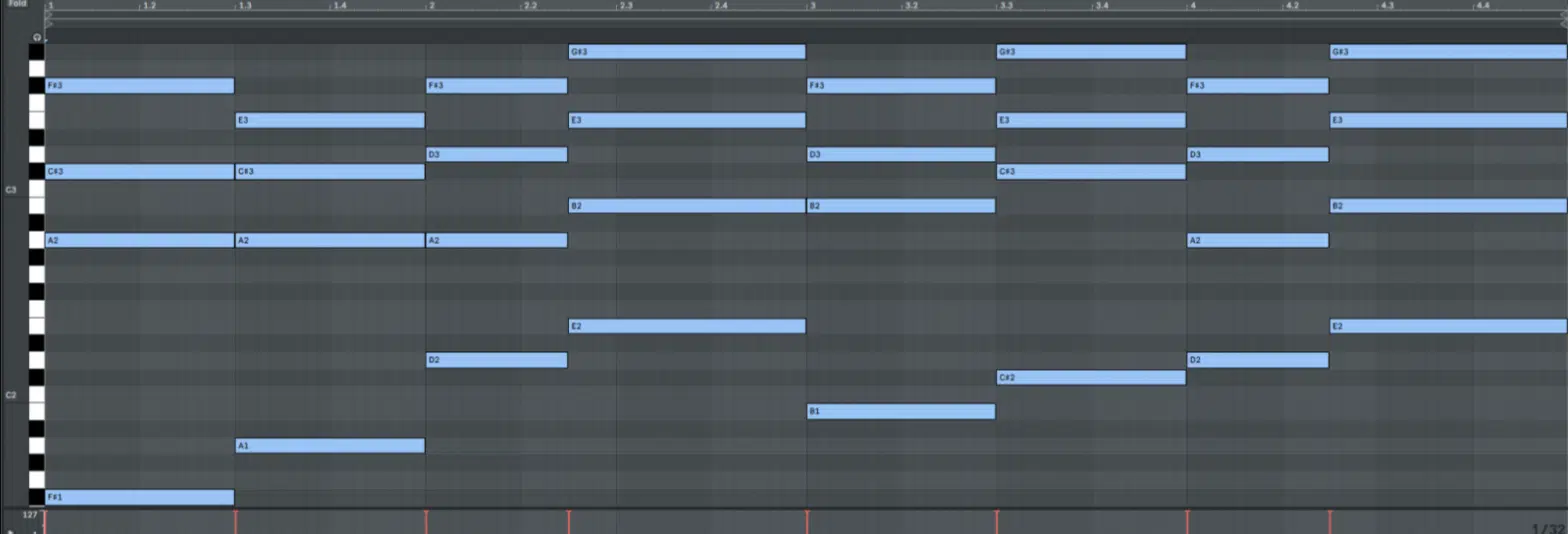
EDM Chords
Chords are combinations of multiple notes played together, and they’re super important in music notation for creating harmony and learning how to read music.
The simplest form is the triad, which contains a root note, a third, and a fifth (for example, a C major triad includes C, E, and G).
When you’re learning how to read music, you’ll often see chord symbols above the staff, such as C for a C major chord or Am for A minor, to indicate harmony.
These symbols make it easier to play chords without having to read every note individually.
If you’re looking at a C major chord in sheet music, recognize it as a building block for much larger arrangements, whether it’s a piano piece or a song.
Learning to identify chords at a glance is ideal for smooth sight reading and for understanding the harmonic structure of a piece.
NOTE: Remember, minor chords (like A minor) use a flattened third 一 giving a darker tone compared to major chords.
By memorizing (and playing around with) these chord symbols and formations, you’ll not only read music more efficiently but also be able to apply these chords when composing or playing along with other musicians.
Like, for example, let’s say you’re recording an artist but he all of a sudden wants a different vibe… You’ll be able to lay it down on your MIDI controller right on sight.
Dynamics, Articulations, and Expression Marks
When learning how to read sheet music, you have to get familiar with dynamics and articulations. They’ll help you express the intensity and character of your music. Bottom line, understanding to interpret dynamics and expression marks will help you convey the intended emotion in any piece.
-
Dynamics: Playing Soft and Loud

Dynamics indicate how soft or loud you should play a passage in sheet music, and the most common ones are:
- pp (pianissimo, meaning very soft)
- p (piano, meaning soft)
- mf (mezzo-forte, medium loud)
- f (forte, meaning loud)
For example, when you see pp on the staff, it’s a cue to play gently, which can add an intimate, delicate feel to the music.
On the flip side, ff (fortissimo) means to play very loudly, creating a bold, powerful sound that’s super in your face.
As you practice reading sheet music, pay close attention to these dynamic markings 一 they’re not just about volume, but also about energy and expression as well.
If you’re playing something marked crescendo, gradually increase the volume to build tension, while a diminuendo calls for a gradual decrease.
These subtle shifts make all the difference in performing music with show-stopping emotion and intensity.
It lets you move beyond just playing the notes to fully conveying the feel of the piece, giving you mad ‘professional’ vibes.
-
Articulation Symbols: Staccato, Legato, and More
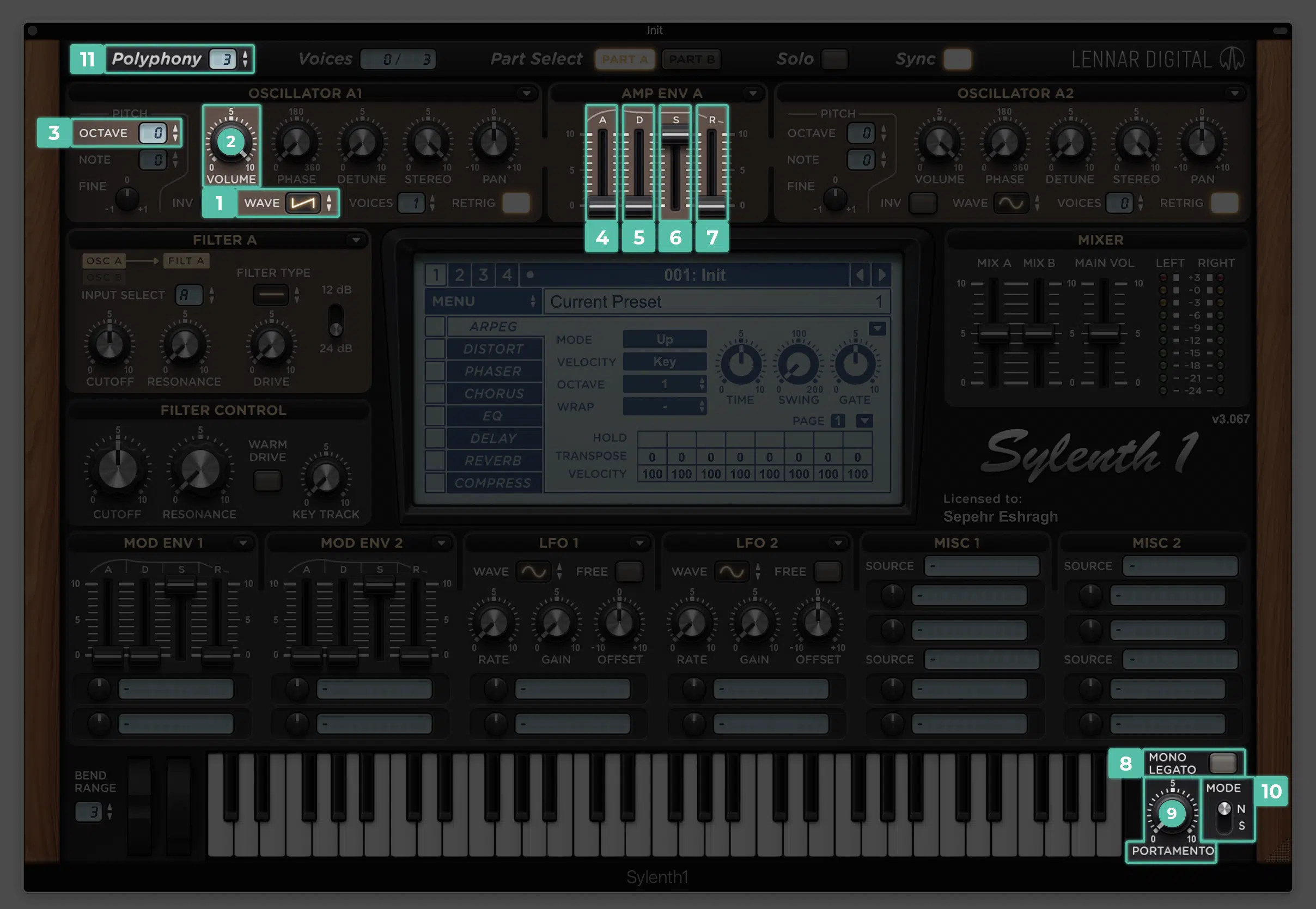
Articulation symbols in sheet music tell you how to play each note, adding character and style beyond just pitch and rhythm.
Staccato, for example, is indicated by a small dot above or below a note, signaling you to play it short and detached; great for creating a bouncy or punchy feel.
Legato (often shown with a curved line or “slur” connecting notes) means playing all the notes smoothly and connected to create a solid, flawless sound.
Another common symbol, accent (marked with a “>” sign above or below a note), instructs you to play that note louder or with more emphasis.
It adds a punch to your reading sheet music performance.
When you read sheet music, or are learning how to read music these articulations will bring your music to life 一 helping each note convey the intended expression.
When you see a tenuto mark (a small line above or below the note), play the note with a slight emphasis, holding it for its full note value.
If you’re aiming for expressive music-reading skills, you should practice adding these articulations even when you’re sight reading.
They’re key for interpreting the piece’s intentions and making the music sound authentic.
-
Expression and Tempo Markings

Expression and tempo markings tell you not just how to play the notes but also the overall feel and speed of the music.
Common tempo markings give you a sense of the music’s pace, helping you adjust your playing style, like:
- Allegro (fast)
- Andante (walking pace)
- Adagio (slow)
For example, if you see Allegro at the beginning of sheet music, it’s your cue to play with energy and speed, while Largo would indicate a much slower, more deliberate pace.
Some markings, like ritardando (gradually slowing down) or accelerando (gradually speeding up), appear within the music to guide you through tempo changes.
These are super helpful for keeping the music dynamic and engaging 一 making each passage feel purposeful.
Expression markings like dolce (sweetly) or con fuoco (with fire) give you a stronger sense of the emotional tone, which is vital for advanced reading sheet music.
Advanced Reading Techniques and Sight-Reading

As you develop your music-reading skills and learn how to read music better, moving into advanced techniques like sight-reading can be insanely rewarding.
Sight-reading is the skill of reading and playing a piece of sheet music you’ve never seen before, and it relies on your ability to quickly recognize (in real-time):
- Notes
- Rhythms
- Key signatures
- Dynamics
Start by breaking down the piece’s structure: look for familiar time signatures, key signatures, and common patterns like repeated chord progressions or intervals.
This can help you anticipate the flow, even when you’re unfamiliar with the exact notes.
One tip is to keep your eyes slightly a (note) head of your playing position, scanning for the next measure or phrase so that your fingers are ready for upcoming notes.
Get it, ‘note head?’ No… Alright, moving on.
Experimenting with rhythmic musical notation with a metronome can be super helpful for maintaining steady timing when sight-reading as I said before as well.
Focus on interpreting articulation and dynamics at sight to capture the music’s full expression, even on a first read.
Building sight-reading skills not only improves your ability to read new music quickly but also makes you more adaptable and precise in other areas of music-making.
Final Thoughts About How to Read Music
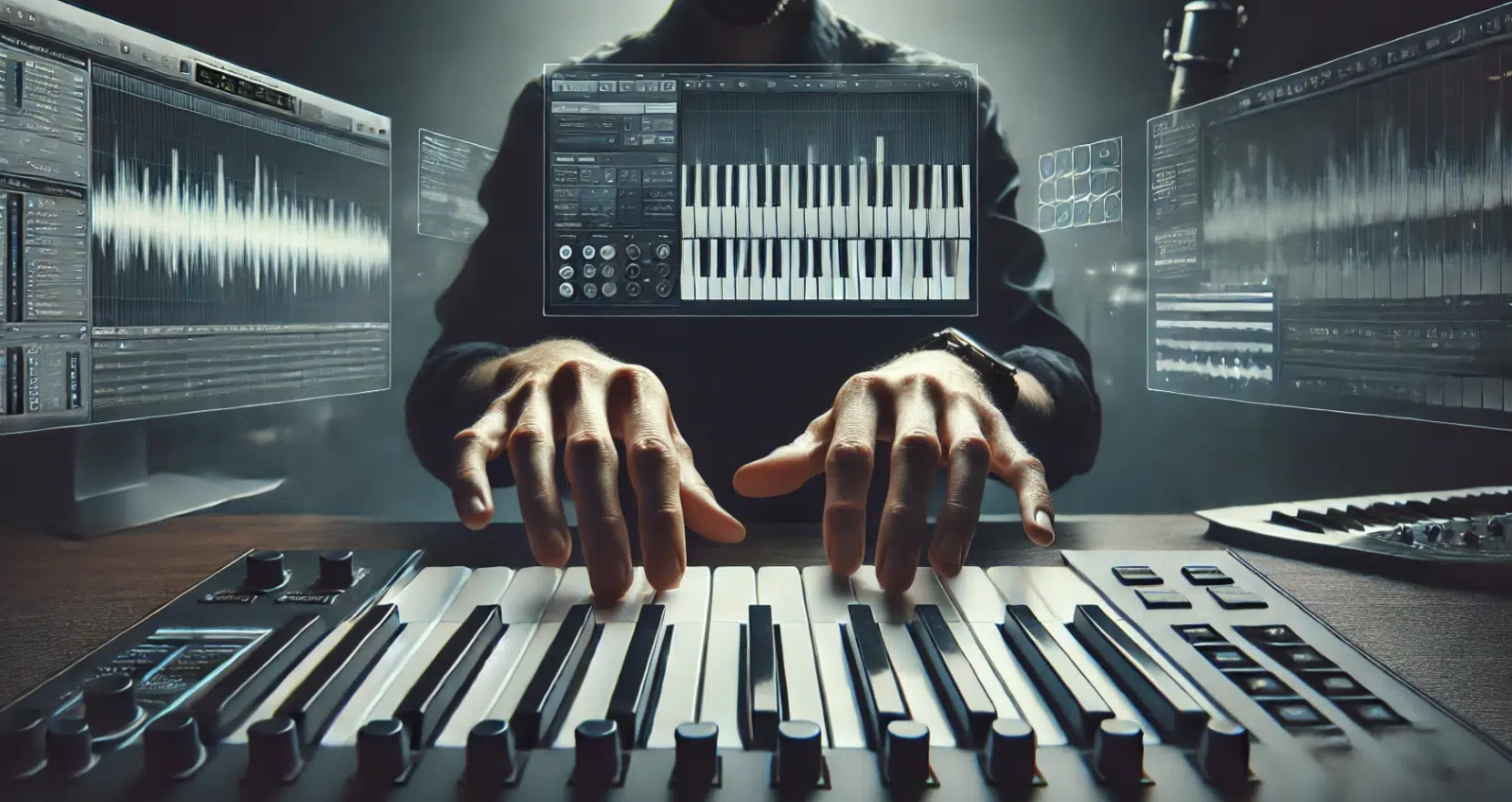
Learning how to read music (especially sheet music) can be a little intimidating at first, that’s for sure.
It requires practice, patience, and a willingness to understand musical symbols, rhythms, and key signatures (which can get a little tricky).
Plus, getting a handle on note values, octave notation, and time signatures can seem like a lot to take in.
But, by using the techniques, tips, and basics we covered today, you’ll be able to confidently recognize notes, interpret rhythms, and understand the structure of music in no time.
Remember, learning how to read music is not about perfection but more about building familiarity and having fun as you dive into the world of music notation.
As a special bonus to help you understand everything we talked about, you’ve got to check out this insanely valuable Free Advanced MIDI Chord Progressions pack.
It includes over 120 professionally-crafted MIDI chord progressions in every major and minor key.
It can help reinforce your understanding of scales and key signatures as we discussed, plus so much more about music theory essentials.
Each progression can be easily dragged and dropped into your DAW 一 making it perfect for practicing the chord structures, intervals, and time signatures we talked about.
It even includes more advanced chord extensions and rhythmic patterns so you can explore complex harmonies and rhythms hands-on.
It’s a great tool to bring all the basics you’ve learned here to life and apply them directly to your own music to blow the competition out of the water.
Bottom line, learning how to read music is a marathon, not a sprint, so don’t expect to nail it down in one day.
Just make sure to stay consistent, motivated, and learning, and keep experimenting every single step of the way.
Until next time…





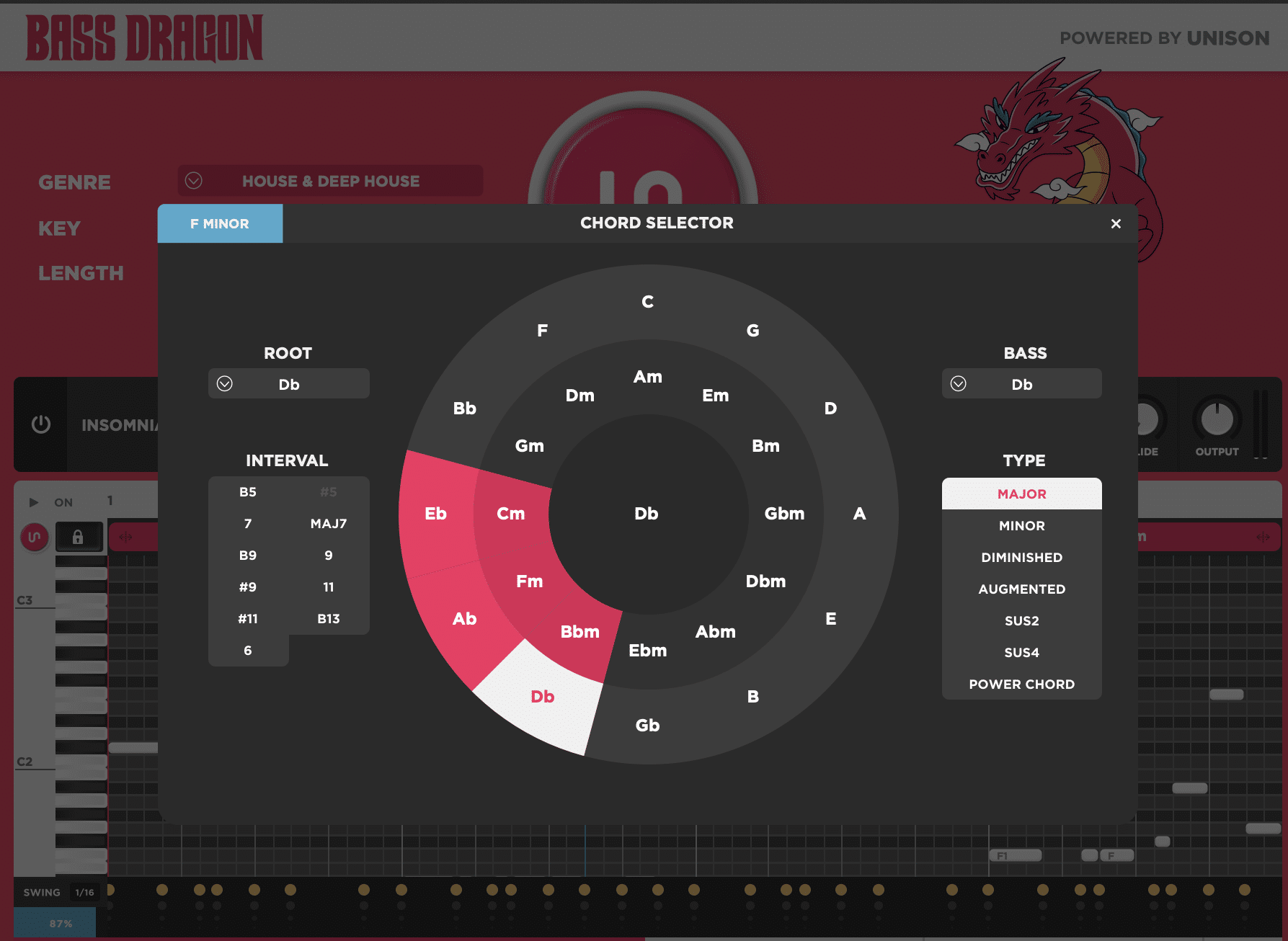


Leave a Reply
You must belogged in to post a comment.